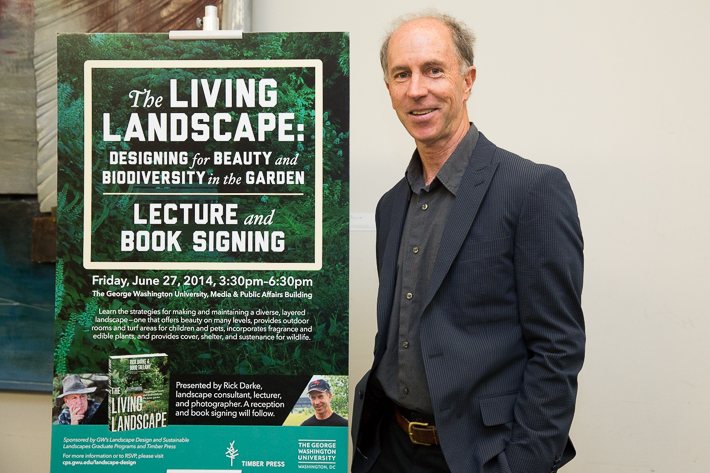By James Irwin
The world has long struggled to accurately define the word “native,” and in doing so often overlooks elements of ecology and cultural geography in the creation and conservation of livable landscapes, according to landscape designer Rick Darke.
“The typical definition is all about us and all about place and time, but not about relationship,” Mr. Darke said Friday at the George Washington University. “That is a deep failure. In fact, the thing that makes any of us native is the nature of our relationships, whether you are a human being, a plant or an animal.”
The author, photographer, lecturer and consultant, who served on staff at Longwood Gardens in Pennsylvania for 20 years, delivered remarks based on his recent book, “The Living Landscape: Designing for Beauty and Biodiversity in the Garden,” at a public lecture Friday evening hosted by GW’s Landscape Design program and Timber Press.
Mr. Darke focuses on regional landscape design, planning, conservation and enhancement. He visually demonstrated how an understanding of living layers and biodiversity can be put to practical use in the making and maintenance of residential gardens and community landscapes. GW Today picked out a few highlights from his presentation.
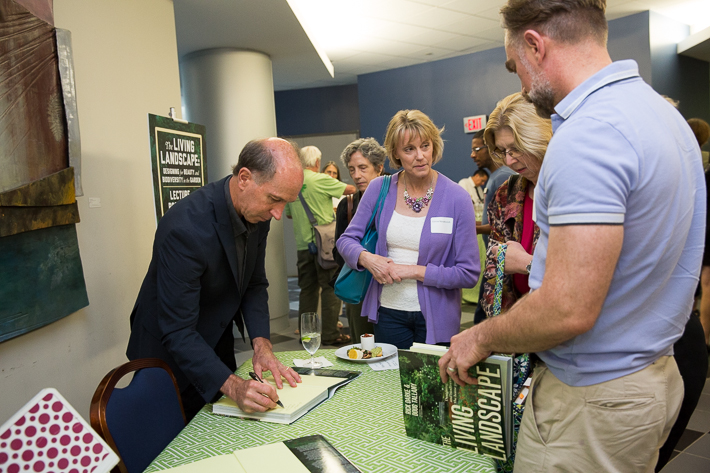
So, what is an accurate definition of “native”? Mr. Darke and “The Living Landscape” co-author Doug Tallamy believe they have a comprehensive definition: “We have to consider process,” Mr. Darke said. “Native is a plant or an animal that is involved in a given place over a period of time sufficient to develop complex and essential relationships with the physical environment and other organisms in a given ecological community.”
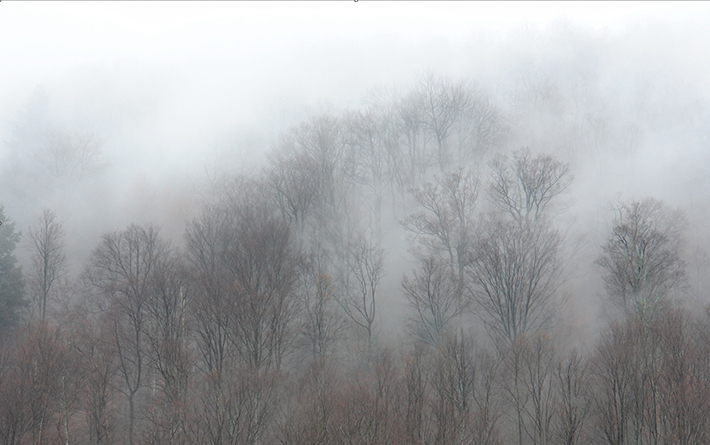 Rolling fog obscures and reveals different things on a hillside, including elements of the landscape that are dead: “We’ve been trained to take the dead branch and get rid of it immediately. We have got to resist that temptation,” Mr. Darke said. “A dead branch is a highly functional part of habitat. … Imperfection and asymmetry in a community of plants like this is what makes it beautiful. You can’t buy that tree, and you can’t chainsaw it down in a way that looks natural. You need slope, seeds and time.”
Rolling fog obscures and reveals different things on a hillside, including elements of the landscape that are dead: “We’ve been trained to take the dead branch and get rid of it immediately. We have got to resist that temptation,” Mr. Darke said. “A dead branch is a highly functional part of habitat. … Imperfection and asymmetry in a community of plants like this is what makes it beautiful. You can’t buy that tree, and you can’t chainsaw it down in a way that looks natural. You need slope, seeds and time.”
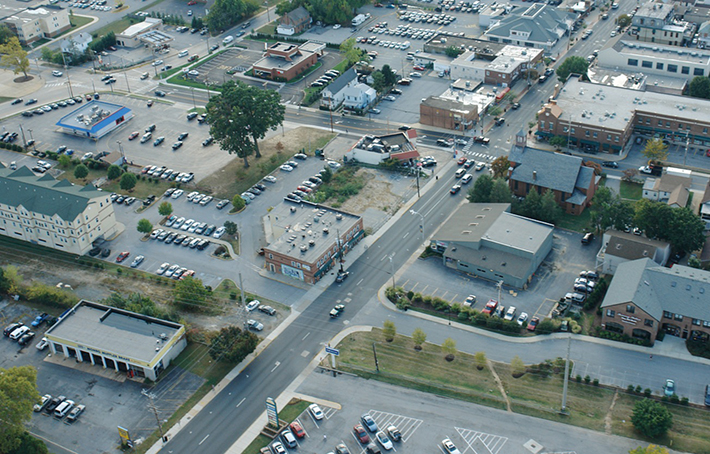 Dichotomy of nature and industry in Newark, Del.: “What do we really do with the layers of landscape? We eviscerate them,” Mr. Darke said. “And we don’t do it saying, ‘We’re going to strip all the layering out.’ We do it because we have purpose. These are two huge old hickory trees. God knows how they got there but nobody is planting trees like that anymore. When they plant new trees, we plant them in nice little circles of mulch, we plant nothing beneath them, so we wind up with not much.”
Dichotomy of nature and industry in Newark, Del.: “What do we really do with the layers of landscape? We eviscerate them,” Mr. Darke said. “And we don’t do it saying, ‘We’re going to strip all the layering out.’ We do it because we have purpose. These are two huge old hickory trees. God knows how they got there but nobody is planting trees like that anymore. When they plant new trees, we plant them in nice little circles of mulch, we plant nothing beneath them, so we wind up with not much.”
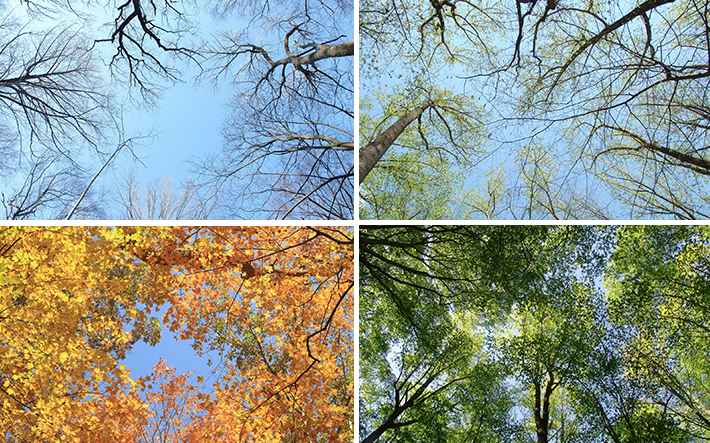 (Clockwise from top left) A canopy of trees provides a glimpse at nature’s umbrella: “Think about engineering for a second,” Mr. Darke said. “If you said you wanted to create a machine that provided access to sun and shade, let us read books by the daylight, let the heat of the sun get through, and then close up like an umbrella and cool everything when it gets too hot, well, that’s what trees are; they’ve already been invented. We have to look at function. The canopy is a highly effective layer.”
(Clockwise from top left) A canopy of trees provides a glimpse at nature’s umbrella: “Think about engineering for a second,” Mr. Darke said. “If you said you wanted to create a machine that provided access to sun and shade, let us read books by the daylight, let the heat of the sun get through, and then close up like an umbrella and cool everything when it gets too hot, well, that’s what trees are; they’ve already been invented. We have to look at function. The canopy is a highly effective layer.”
 Time and process create things man cannot: “This tree is at least 200 years old, maybe 300,” Mr. Darke said. “It takes a long time to do that. I can put my hand into the fissures of that chestnut oak bark.”
Time and process create things man cannot: “This tree is at least 200 years old, maybe 300,” Mr. Darke said. “It takes a long time to do that. I can put my hand into the fissures of that chestnut oak bark.”
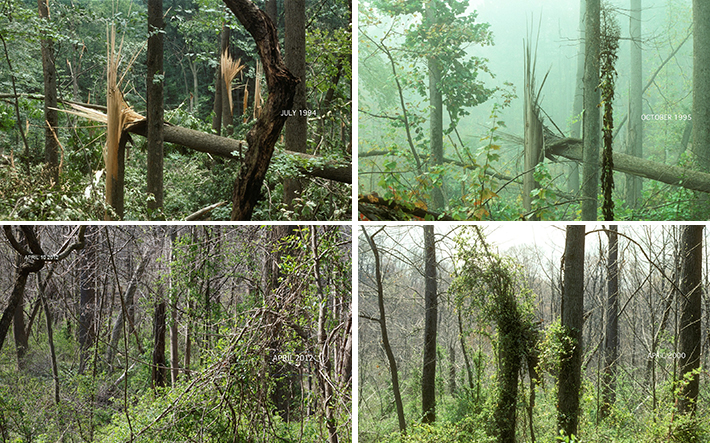 (Clockwise from top left) Mr. Darke started conducting an informal study in 1994 right after a tornado struck a wooded area: “It was an opportunity to prove what would happen if you let nature take its course,” he said. “Nature is not going to repair everything and put it back where it was. The lesson here—if you’re a restoration ecologist—is that if you wait too long to go in here and change things, it’s going to require huge machinery. If you start earlier, right after the tornado, you can observe and you can teach people to understand desirable and undesirable elements—and you can pull it out by hand. Opportunity is presented for a while, but not forever.”
(Clockwise from top left) Mr. Darke started conducting an informal study in 1994 right after a tornado struck a wooded area: “It was an opportunity to prove what would happen if you let nature take its course,” he said. “Nature is not going to repair everything and put it back where it was. The lesson here—if you’re a restoration ecologist—is that if you wait too long to go in here and change things, it’s going to require huge machinery. If you start earlier, right after the tornado, you can observe and you can teach people to understand desirable and undesirable elements—and you can pull it out by hand. Opportunity is presented for a while, but not forever.”
 Mr. Darke planted this beech tree in his backyard 16 years ago: “We took beeches from a nursery in the Carolinas that were about 10 feet high and planted them as part of a grove project at Longwood,” he said. “Those beeches now are about 16 to 18 feet tall. I planted this tree, from a seedling in our garden five years later; it’s now 25 feet tall. You just have to have faith. Small trees, planted with good root systems, are going to outgrow big trees every single time.”
Mr. Darke planted this beech tree in his backyard 16 years ago: “We took beeches from a nursery in the Carolinas that were about 10 feet high and planted them as part of a grove project at Longwood,” he said. “Those beeches now are about 16 to 18 feet tall. I planted this tree, from a seedling in our garden five years later; it’s now 25 feet tall. You just have to have faith. Small trees, planted with good root systems, are going to outgrow big trees every single time.”


